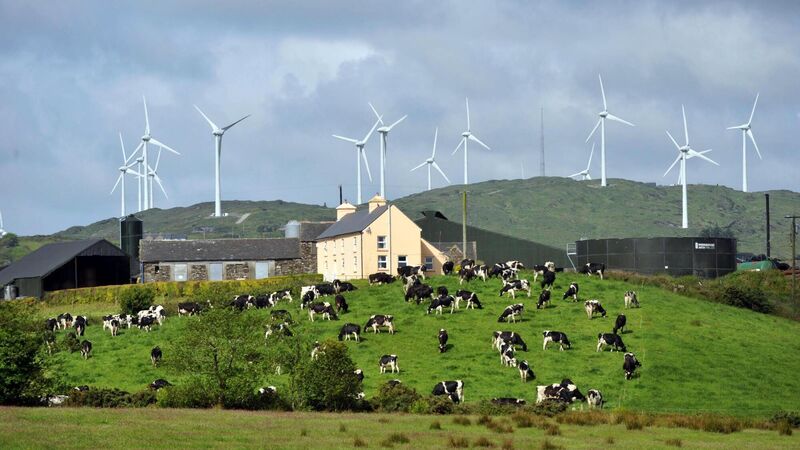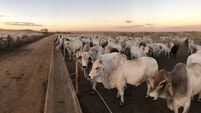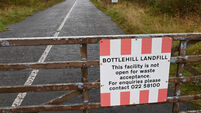Government sets out plans for 22-30% reduction in farming emissions

Cows graze on green grass not far from hilltop wind turbines in County Cork in 2021. Picture: Don MacMonagle.
The Government has committed to launching a research programme to develop new technologies and feed additives to lower farm emissions within the next decade.
This afternoon the Taoiseach, Micheál Martin, set out his goal that agriculture should reduce emissions by 22% to 30% by 2030. The target for agriculture was considerably lower than those set for other sectors.
- Agriculture: 22-30%;
- Electricity: 62-81%;
- Transport: 42-50%;
- Buildings: 44-56%;
- Industry/Enterprise: 29-41%;
- Land Use, Land Use Change and Forestry: 37-58%.
The Government hopes to achieve the reduction through a combination of low-carbon farming practices, such as encouraging organics and reduced fertiliser use.
Earlier finishing for beef cattle, genetic selection for low-emission animals, reduced crude protein content rations, and increased use of clover and multi-species swards are among other key measures proposed.
A 'significant' rewetting of peatlands, increased tree planting, more efficient grassland management and a target to increase the area under cover crops to 50,000 hectares by 2030 will also boost the rate of carbon sequestration.
The Taoiseach said the Government said it would explore the development of a carbon farming model and plans to introduce a small-scale electric generation scheme for farmers to generate their own electricity and sell the surplus back to the grid adding that farmers would be incentivised to make the proposed changes.
"This plan will give Irish agriculture a viable future, producing world-class food with a lower carbon footprint, thanks to a science-based approach that also improves biodiversity and protects nature," a spokesperson said.
"Climate Action Plan 2021 places farmers at the very centre. The targets for agriculture will help make Irish farms more carbon-efficient and build a more resilient agri-food sector.
"There will be a reduction in chemical nitrogen and more targeted use of fertiliser, while maintaining our position as global leader in grass growth through multi-species swards. Other measures include improving the genetics of our herds to reduce emissions and improve productivity.
"These changes are good for the environment but importantly make sense economically."
The Climate Action Plan follows the Climate Act 2021, which commits Ireland to a legally binding target of net-zero greenhouse gas emissions no later than 2050, and a reduction of 51% by 2030. These targets are a key pillar of the Programme for Government.
The plan sets out indicative ranges of emissions reductions for each sector of the economy. It also sets out the actions needed to deliver on our climate targets.
Environment Minister Eamon Ryan added: "It's our chance to make the right choice and create a new Ireland where we cut our dependence on fossil fuels, and develop our own renewable resources, including offshore wind.
"A country with cleaner air and water; where homes are warmer and cheaper to heat. Where walking and cycling are safe and accessible, public transport is greener and more frequent, and the rollout of electric vehicles is supported nationwide. Where our food is produced in a greener, cleaner way that also protects nature and supports farmers' incomes."
However, Irish Farmers' Association president Tim Cullinan warned the emissions ceiling for agriculture will be "extremely challenging" and could have a profound impact on the rural economy.
"The Government has fixed these targets without any proper assessment of the implications for individual farmers, the rural economy or food production," he said.
"We cannot approach climate policy with a silo mentality. Carbon leakage, food security and farmers' livelihoods must be fully integrated into the plan."











